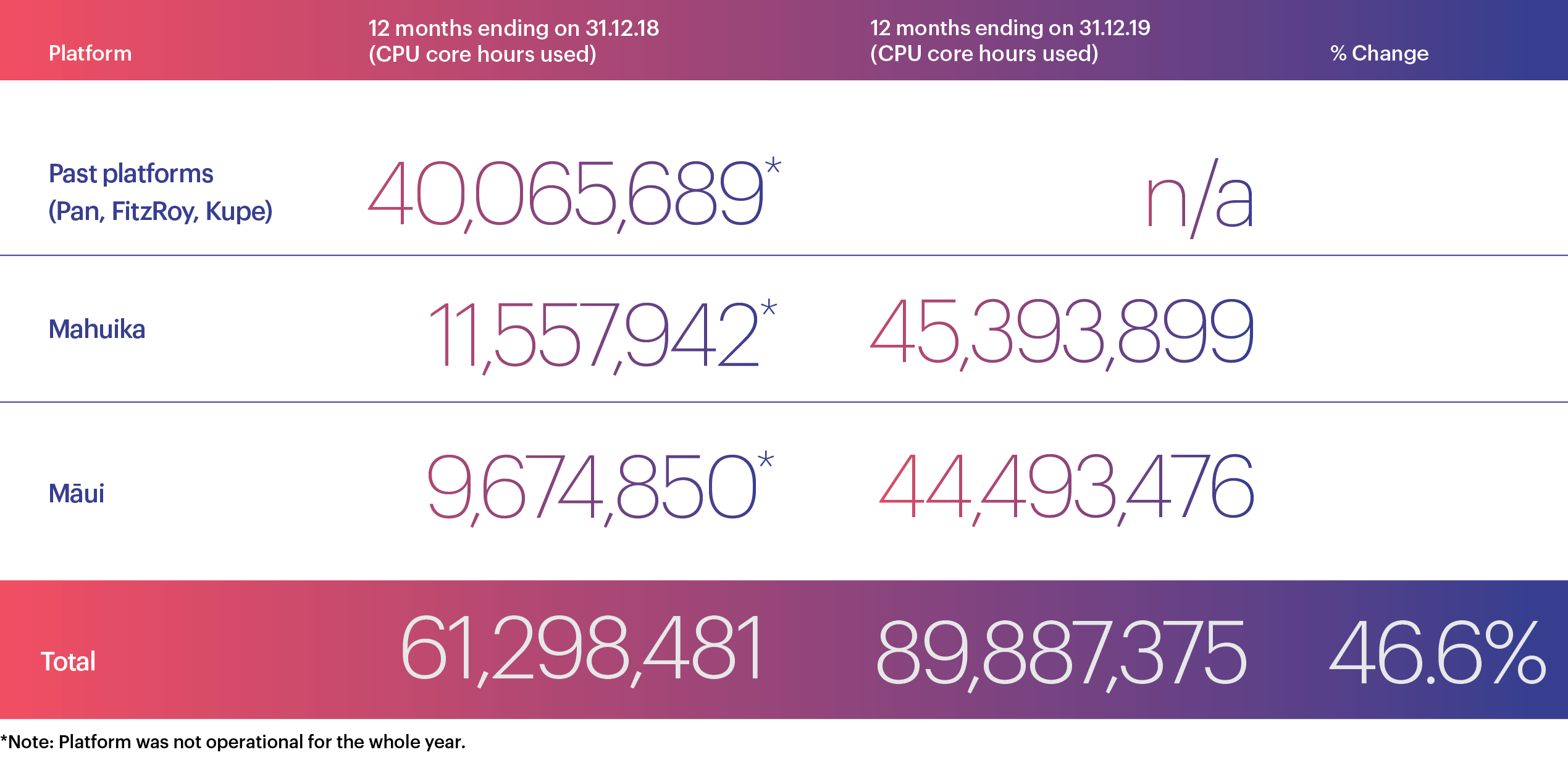Increase fit-for-purpose use of national research infrastructure
Rapid growth in demand of NeSI’s new infrastructure is evidence of unmet needs within the research sector and demonstrates a vote of confidence in NeSI as an essential connection within New Zealand’s eResearch ecosystem.
As computational capabilities develop, research becomes possible at larger scales, with finer resolutions, and addressing even greater complexity. A large focus during 2019 has been to roll out enhanced and new services, layered upon the national platform, to deliver fit-for-purpose support and capabilities to research projects across a number of fields, from machine learning to genomics to climate modelling.
In particular, NeSI focused on enabling researchers to gain more insights and create more intuitive solutions using analytics and machine learning. Expertise in areas of machine learning has been developed within NeSI’s Computational Science Team, and shared through Consultancy projects (see case study on Page 50). New content outlining available resources and tools for leveraging machine learning on NeSI systems was added to the NeSI website in July 2019, and new training materials are being developed to support researchers in these areas.
Lifts in utilisation through fit-for-purpose allocations
During 2019, NeSI focused on delivering fit-for-purpose allocations across its national pools, which has seen results of significant lifts in utilisation of Māui by a broader range of institutions. Māui usage in particular has been driven by the Deep South Challenge and Earth System Modelling research from NIWA, joined in the later half of 2019 by projects out of Victoria University, the Auckland Geothermal Institute, and QuakeCoRE. As usage grows, NeSI is committed to optimising the platform, its allocation, and its fair use (see below). Enhancements and expansions to NeSI’s stakeholder reporting process resulted in new monthly formats developed for Collaborators and Subscribers to enable all parties to better understand usage patterns, opportunities for targeted support or training, and areas for improvement.

Drivers for growth in usage
During 2019, increased utilisation has come largely from Collaborators across the total platform (Māui + Mahuika). Outside of the Collaborators, the Merit and Subscription schemes have brought in a number of heavy user groups in wider institutions such as Massey University, Victoria University of Wellington, and LIC, who have been working at scale for a number of years. Last year, GNS and Genomics Aotearoa’s work scaled up with subscriptions and this year AUT began a push to get a number of its researchers on to NeSI.
NeSI continues to grow its user base through strong partnerships with Genomics Aotearoa, which has also opened doors for building engagement with Plant & Food Research, AgResearch, and ESR. At the University of Waikato, NeSI supported a new Masters level paper designed to prepare New Zealand postgraduate students for learning and building the skills required for computational research, no matter what their field of science (see case study on Page 48). Meanwhile, new compute subscriptions from AgResearch and AUT enabled a new cohort of researchers at those institutions to access NeSI services driving up active projects (see below).

Improvements to research programmes and allocations management
During 2019, NeSI reviewed its resource allocation processes and practices to identify areas for improvement and enable greater flexibility in supporting an increasingly diverse set of projects. NeSI also reviewed and refined the way it stores researcher, project, and allocation information in its internal databases, towards a goal of improving its user journey mapping and stakeholder reporting processes. Design work on a new NeSI research project database is currently in test mode, with the focus of the new design aimed at supporting multiple resource type allocations (HPC core hours, GPUs, consultancy) and introducing programmes and contracts into the existing data schema.






